Good day,
I have been wanting to conduct a personal field test of my survival equipment/ability in a typical fall situation; like getting lost while hunting moose in northern Ontario and having to spend the night outdoors with only the gear on you.
The trouble is that I am very busy in the fall; working, instructing with our local youth group and actually hunting. So this week I conducted the exercise in the early spring as the weather and forest conditions are very similar.
I did a recce to the general area (about 35 km from my home) on Sunday afternoon with my family to determine that the roads were passable, as the electronic 4x4 selector switch on my truck is broken.
I was very busy on Monday planning/booking our summer vacation trip to Bristish Columbia, so it was 4.00pm by the time I grabbed my normal hunting gear, skipped supper and headed for the bush.
I had to chop a tree off the road on the way into the site and at about 5.00pm left my truck parked about 1 km from the area.
The temperture was app. +15*c, but there was still patch snow in the shady sections of the bush. I hiked an old pole-line to a dry beaver marsh, where I walked north about 200m up the bank of the flowing creek, to the head of the clearing. I have actually hunted moose in this area before (unsuccessfully) so the scenario was realistic.
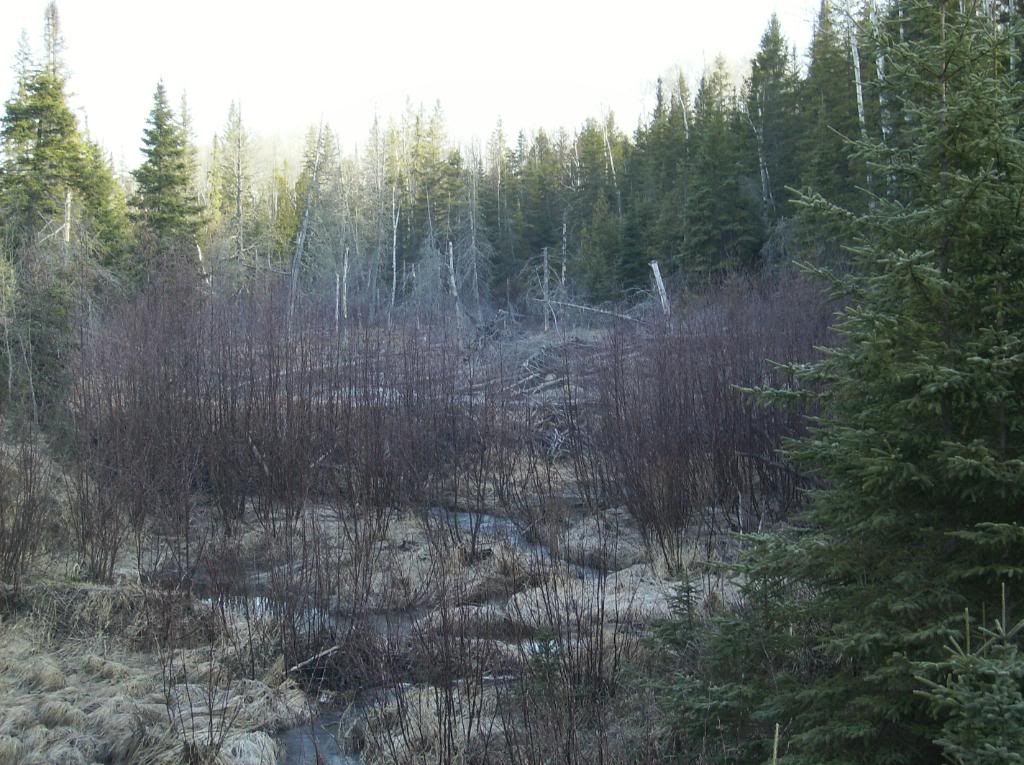
Dry beaver marsh looking north from pole line.
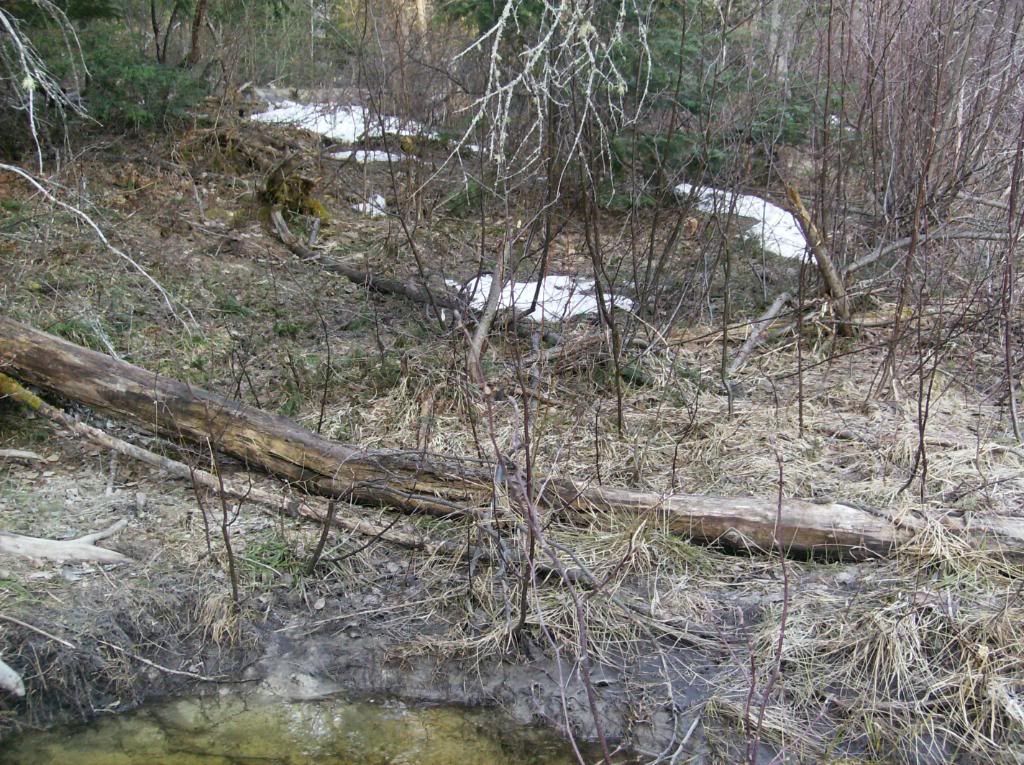
Patchy snow along creek in dry beaver marsh.
The forest floor surface was very dry especially on the upland sites and I was very concerned about the danger of a "pre-green up" spring fire. Therefore I selected a bivouac site on the edge of the marsh, probably lower than I would in the fall. It was now 5.45pm and I needed to get started on construction ASAP.

The bivouac site as I found it.
I built a tapered lean-to by tying a pole to a tree, anchoring the end into the ground and bracing other poles against it. I stretched an
All-Weather Blanket over the framework, I keep this small reflective poly-tarp in an orange nylon bag and use it as a dry seat while stand hunting. I made the shelter a little too high and deep so the the tarp was not quite long enough to cover to the ground, this caused a draft that I felt later in the night. I should have sealed the gap with moss and logs. The tarp is about 10 years old and has many duct tape patches, I made a few more tears in it on branch stubs while covering the shelter.
I then cut 4 balsam fir saplings and stripped the branches from them at the biv site. These I arranged twig end down to create a browse bed about 30cm thick; the ground under the surface layer was wet and cold so it was important to insulate myself from it.
Due to the fire danger I excavated the duff layer down to mineral soil and constructed a small fireplace about 1m in front of the shelter. Rocks and green wood were scarce so I made a base of wet logs, a reflector of thin green popular poles and put the only rocks I could find between my bed and the fire.
There was lots of standing dead wood in the marsh but it was almost all balsam fir, which makes very poor firewood (short lived and lots of sparks). I did locate one small dry black ash tree and numerous outer pine stumps as a result of logging in the area about 100 years ago.
I did the bivouac site construction in this order because I was rapidly losing daylight and felt that I could gather adequate firewood around camp after dark if I had to, using only my headlamp.
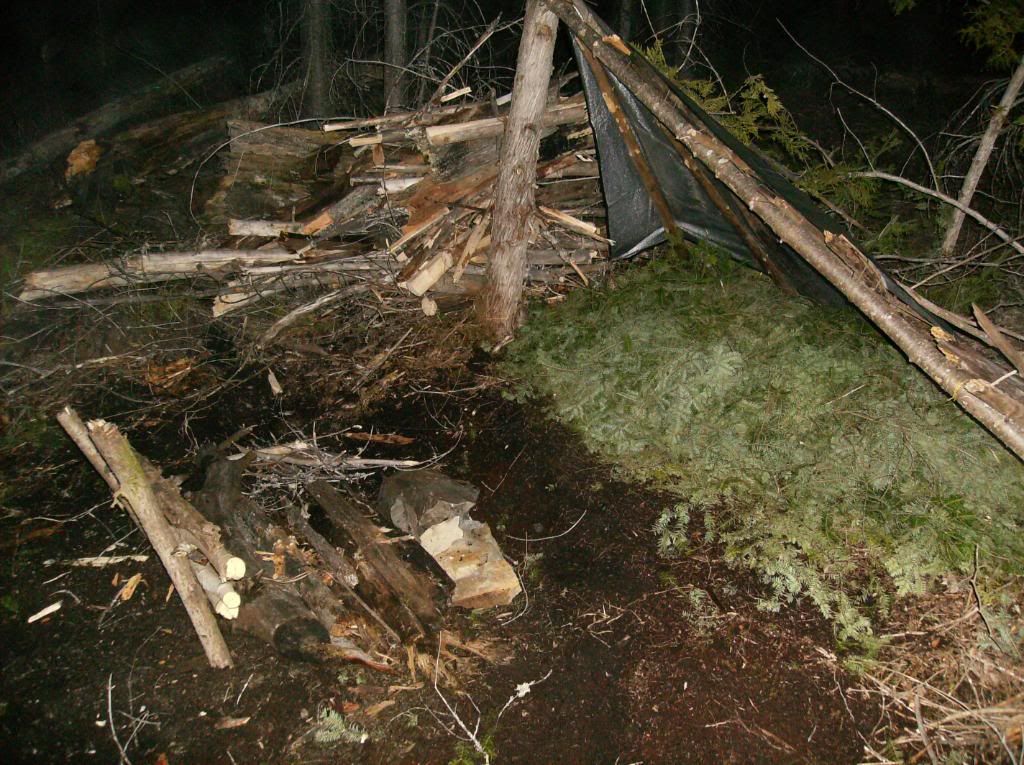
Shelter site at dark, I am just about to build a fire.
Throughout the shelter construction I felt very rushed as I knew I only had a couple hours till dark. If I had to gather enough evergreen boughs to cover the shelter instead of using the tarp it would have taken much longer to build.
I used 2 short lengths of para-cord to build the shelter but much thinner cord or fishing line would have worked as well.
I used only one tool to construct the biv site, a 25 year old Fiskar Brush-hook (billhook). This is a simple short heavy machete with curved blade and hooked tip. I bought this tool in the early 80's and have used it hard ever since. A slightly different version of "Brush Axe" is available from
Fiskar/Gerber , it has a different blade shape and hollow handle. Wetterling also has a "Clearing Blade", which I own but have not tried yet. It can be seen on the
Wetterlings site under camping tools.
I used a Bahco
Laplander saw to cut the firewood to length. It did a good job for it's small size but a bow saw would have been quicker. Some larger logs I just dragged back to camp and burnt through to make them smaller.
Tough leather groves are also important for both shelter contruction and working with the fire; I had an old pair and still got some nasty cuts/slivers on my hands.
I dug into my AMK/DR PSK kit to try the Sparklite and Tinder-Quik, it caught on the 3rd strike and I lit the birch bark under my twig bundle; I had an instant fire.

Here you see my old Brush-hook, the Spark-lite and burning Tinder-Quik.
I then gathered my equipment into the shelter and took this picture of some of the tools I had with me.
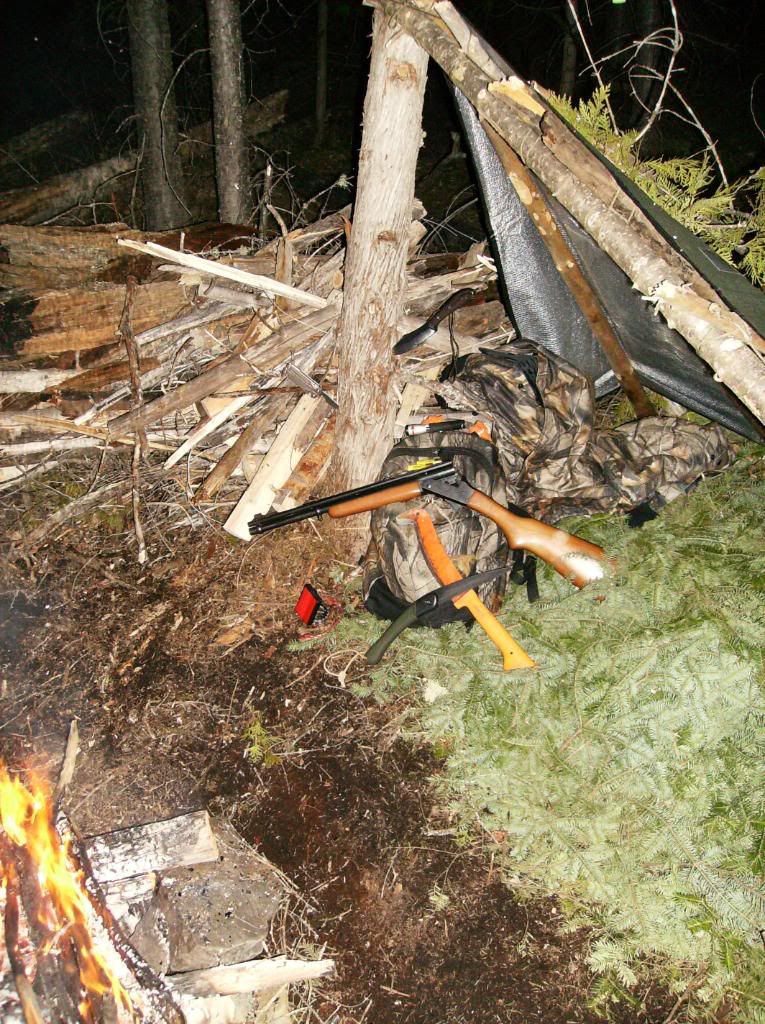
Leatherman TTi,
Grohmann #4 Survival Knife , SAK AA flashlight, Savage M24 .22RF/20ga Combo Gun, Silva 15T Compass, Laplander saw, old Fiskar Brush-hook. My Petzl headlamp was on my head, where it stayed throughout the night, it was terrific.
It was fairly warm during the day and I traveled, worked in a long sleeve synthetic undershirt and light pants. About 10.00pm I made a cup of tea over the fire and changed into my normal fall hunting clothes.
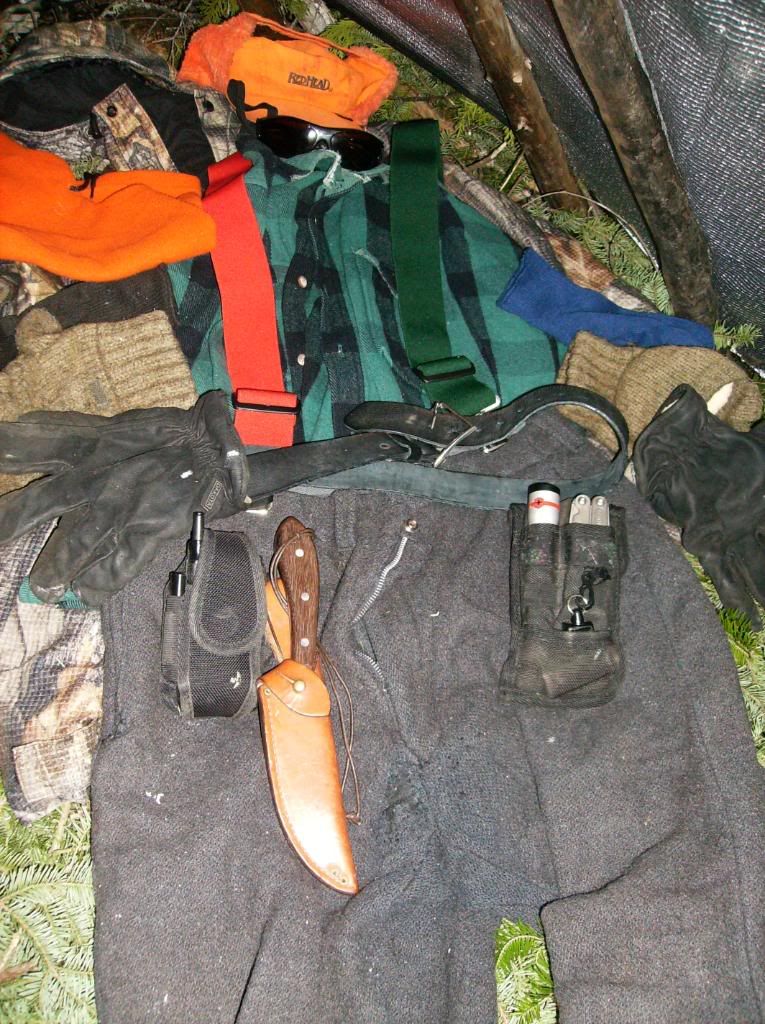
Gore-tex/thinsulate hunting hat, fleece neckwarmer, synthetic long underwear, poly liner socks, wool socks, wool shirt, wool pants, Red/Green suspenders, leather belt, Danner "Trophy" insulated leather boots, poly glove liners, wool "flip" mitts. Later in the night I added a thinsulate liner coat, camo rain overcoat and pants. I also had my cell phone
Mini EDC Cell Phone Kit and Bolle Sunglasses.
It got a little windy and quite cold dropping to at least freezing (0*c) because the puddles in the marsh froze over. Sleeping was difficult because of the bright light of the fire right in front of me, the bright moon and the roaring noise from large rapids/waterfalls about 800m and 1500m from me. I also had to be careful of sparks from the fire shooting embers into the shelter, I would have appreciated much better firewood.
Rest consisted of 10 minutes of dozing, 10 minutes of light napping, 10 minutes of procrastination, then getting up to add wood to the fire.
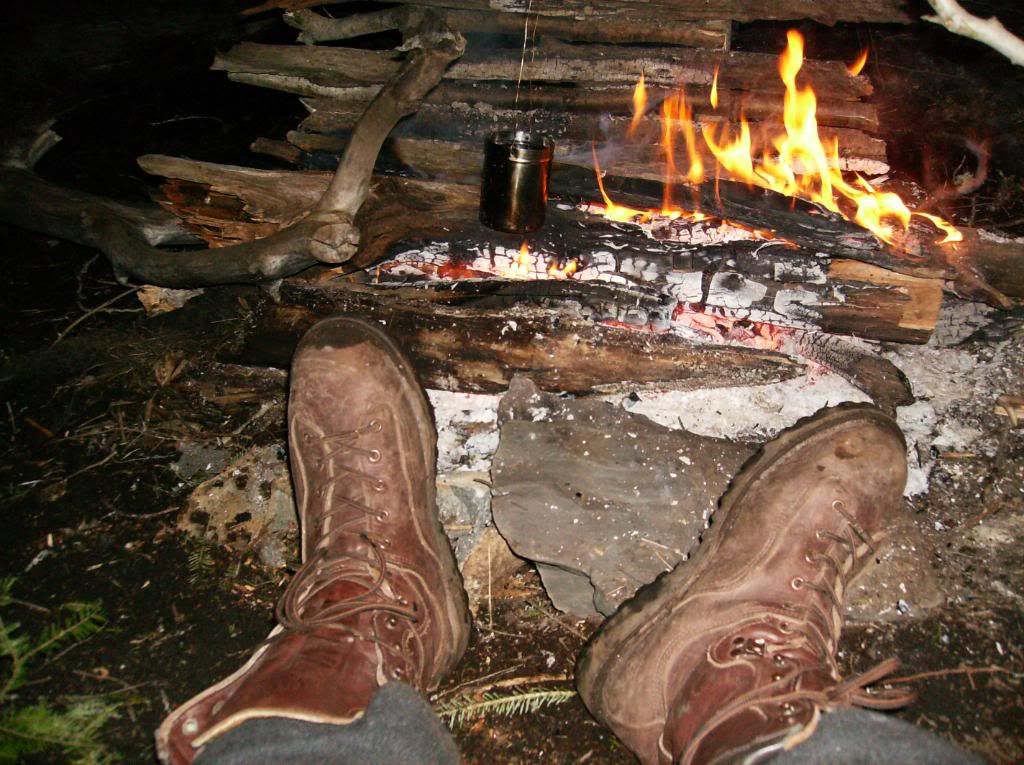
At around 2.00am I felt chilled so I made an OXO beef broth hot drink in a stainless steel container hung over the fire and ate a Vector energy bar, I felt warmer after this.
The first bird sang at 4.58am and by 5.30 it was getting bright in the marsh.
I had instant coffee and an oatmeal bar for breakfast; the camp packed-up quickly because they was not much to it.

Extinguishing the fire took a long time because I needed to be absolutely sure it was out. Even after it was totally extinguished and the charcoal was moved to the marsh puddles I still waited around for an hour, just to be sure.
I left the site at about 8.00am and walked out on the other site of the creek; as usual I found a better shelter site there!
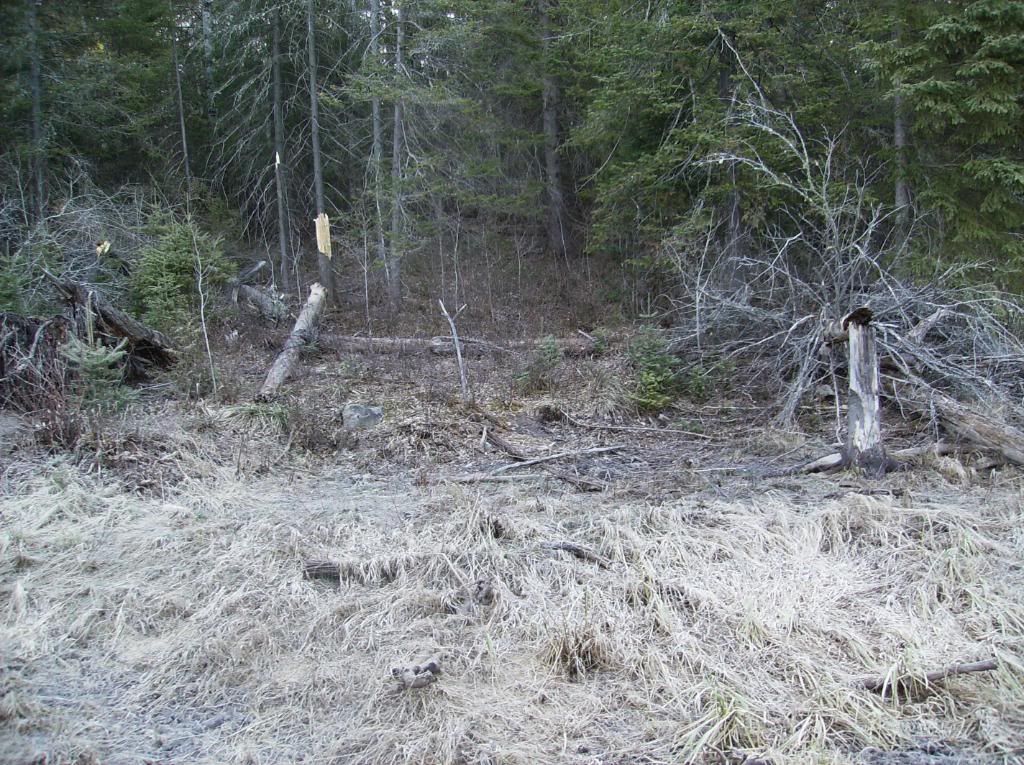
On the poleline road I saw the tracks of a large wolf that had passed by in both directions sometime during the night? (Note: the picture of the tracks does not seem to want to post, I will work on it?)
So I hiked out to the truck, drove to town and ordered a big greasy breakfast bagel sandwich at the drive thru, it and a coffee tasted fabulous.
This post is really long so I will cut it off here and add to it about the lessons I learned later.
For now, I will say that I have a new found respect for those who endure and overcome a true wilderness survival situation.
More info (if you want to hear it) soon,
Mike